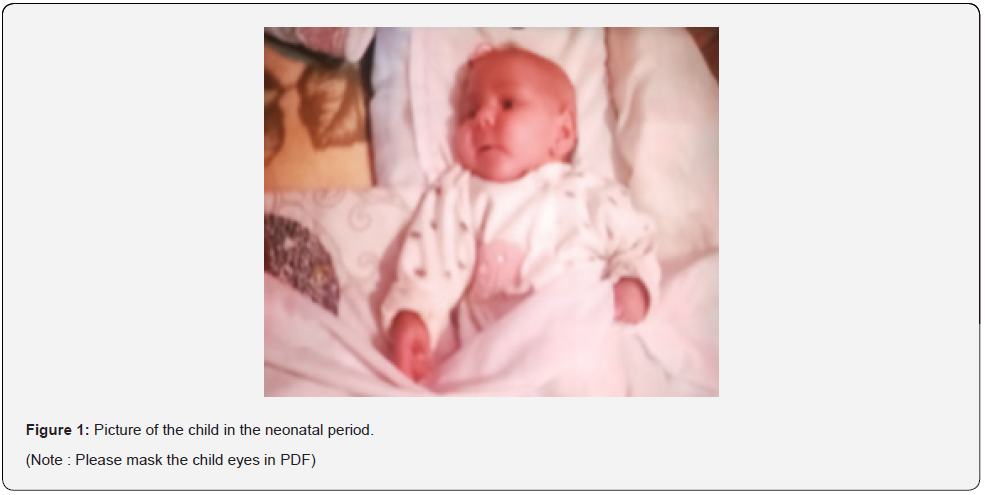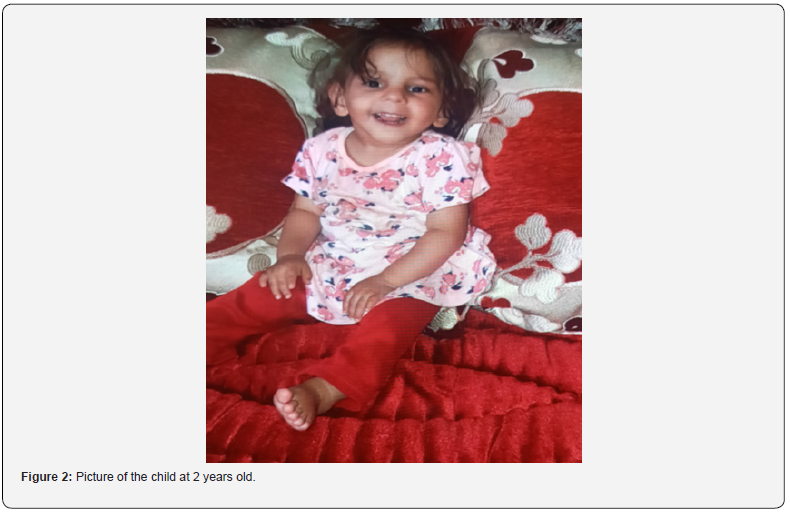Sanjad-Sakati Syndrome in a Moroccan Girl: A Case Report
Ghita Hachim*, Rachid Abilkassem, Abdelhakim Ourrai, Amal Hassani and Aomar Agadr
Pediatric Department, Mohamed V Military Training Hospital Rabat. Morocco
Submission: September 01, 2022; Published: November 18, 2022
*Corresponding author: Ghita Hachim, Pediatric Department, Mohamed V Military Training Hospital Rabat. Morocco
How to cite this article:Ghita H, Rachid A, Abdelhakim O, Amal H, Aomar A. Sanjad-Sakati Syndrome in a Moroccan Girl: A Case Report. Acad J Ped Neonatol 2022; 12(2): 555888. 10.19080/AJPN.2022.12.555888
Abstract
Sanjad-Sakati syndrome (SSS) is a rare autosomal recessive genetic disease characterized by congenital hypoparathyroidism, growth retardation, dysmorphic syndrome, and intellectual deficiency. We report the case of a Moroccan girl, of 1st degree consanguineous parents with a history of intrauterine growth retardation and neonatal convulsion, who presents with facial dysmorphia, growth retardation, and intellectual developmental delay and whose genetic study was in favor of a Sanjad-Sakati syndrome, treated with calcium and vitamin D supplementation. The aim of this article is to make this uncommon affection in the Arab world known to practitioners in order to allow for early diagnosis and improve the healthcare.
Keywords: Sanjad-Sakati syndrome; congenital hypoparathyroidism; hypocalcemia
Introduction
Sanjad-Sakati syndrome is a very rare autosomal recessive disorder due to a mutation in the TBCE gene. It is a genetic disorder of the Middle East, first described in Saudi Arabia by Sanjad et al. in 1988 and then in Jordan, Oman, Qatar, Kwait, Palestin, Israeli Arabs, Tunisia, and Morocco. It is due to a mutation of the TBCE (tubulin folding cofactor E) gene on chromosome 1q42-q43 [1,2].
Sanjad-Sakati syndrome (SSS) is characterized by the combination of congenital hypoparathyroidism, growth retardation, intellectual deficit, and dysmorphia (microcephaly, facial, ocular, and dental anomalies) [3].
We report the case of a Moroccan child whose neonatal convulsion hypocalcemia and dysmorphic syndrome were indicative of a Sanjad-Sakati syndrome.
Case Presentation
A 2-year-old child of first cousin parents, with a history of intrauterine growth retardation, a hospitalization for neonatal convulsion and a psychomotor delay (walking at 2 years old, does not speak).
In the clinical examination, a staturo-weight delay with a weight of 9 kg (-2 standard deviation) and a height of 76 cm(-2 standard deviation), microcephaly (cranial perimeter at 46 cm) and a facial dysmorphism (a long face, a pinched nose with sunken eyes) were found (Figures 1 & 2). The biological assessment showed hypoparathyroidism at 4 pg/ml and hypocalcemia at 75.12 mg/l. The cerebral scan and echocardiography were normal. The genetic study showed the presence of a homozygous c.155_166del mutation in the TBCE gene, confirming the diagnosis of Sanjad Sakati syndrome. The child was put on calcium replacement therapy and alfacalcidol for life, which stopped the seizures.
Discussion
SSS is defined by prenatal and postnatal growth retardation as well as seizures. It is characterized by hypoparathyroidism, which causes hypocalcaemic tetany, seizures and intrauterine growth retardation that lasts throughout life. Patients are mentally retarded and have dysmorphic facies [4,5].
Patients typically have long narrow faces, sunken eyes, pinched noses, huge floppy ears, a long filtrum, thin lips, and micrognathia. The biological assessment shows hypocalcemia with hyperphosphatemia secondary to hypoparathyroidism [4,5].
In the neonatal period, complications of hypocalcemia are often found, such as convulsions, nephrocalsinosis, medullary stenosis of the long bones, and bone fractures with a major risk of infection [6].


Sanjad-Sakati syndrome differs from other causes of congenital hypoparathyroidism such as Di-George syndrome, Kenny-Coffey syndrome, and familial hypoparathyroidism in the absence of cardiac disease, lymphopenia, or skeletal anomalies [7,8].
The treatment of SSS is a real challenge for the physician, aimed essentially at correcting hypocalcemia and its complications. It consists of calcium, vitamin D, and growth hormone supplementation for life [8,9].
Conclusion
Sanjad-Sakati syndrome is a rare but well-known entity mainly described in Arab countries, whose metabolic disorders can lead to serious manifestations involving the prognosis, hence the interest of early diagnosis in the neonatal period.
References
- Sanjad SA, Sakati NA, Abu-Osba YK, Kaddoura R, Milner RD (1991) A new syndrome of congenital hypoparathyroidism, severe growth failure, and dysmorphic features. Arch Dis Child 66(2): 193-196.
- Courtens W, Wuyts W, Poot M, Szuhai K, Wauters J, et al. (2006) Hypoparathyroidism-retardation-dysmorphism syndrome in a girl: A new variant not caused by a TBCE mutation--clinical report and review. Am J Med Genet A 140(6): 611-617.
- Kerkeni E, Sakka R, Sfar S, Bouaziz S, Ghedira N, et al. (2015) Sanjad-Sakati syndrome in a Tunisian child. Arch Pediatr 22(9): 951-955.
- Amjad M, Leghlimi S, EL Kettani, S. Ech-Cherif, et al. (2016) Congenital hypoparathyroidism in Sanjad-Sakati syndrome: about a case. In: Annals of Endocrinology. Elsevier Masson p. 435.
- Richardson RJ, Kirk JM (1990) Short stature, mental retardation, and hypoparathyroidism: a new syndrome. Arch Dis Child 65(10): 1113-117.
- Pal K (2010) Sanjad-Sakati syndrome in a neonate. Indian Pediatr 47(5): 443–444.
- Rafique B, Al-Yaarubi S (2010) Sanjad-Sakati Syndrome in Omani children. Oman Med J 25(3): 227-229.
- Bashar M, Taimur M, Amreek F, Sayeed KA, Tahir A (2020) Endocrinological manifestations of Sanjad-Sakati syndrome. Cureus 12(6): e8770.
- A Touati, S Nouri, Y Halleb, S Kmiha, J Mathlouthi, et al. (2019) Additional Tunisian patients with Sanjad–Sakati syndrome: A review toward a consensus on diagnostic criteria. Arch Pediatr 26(2): 102-107.






























